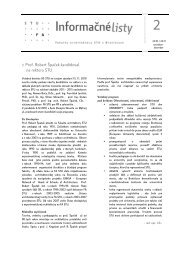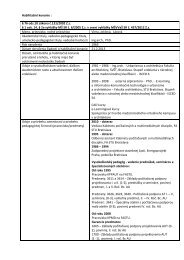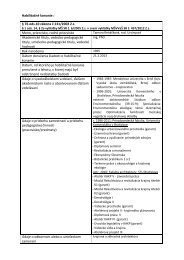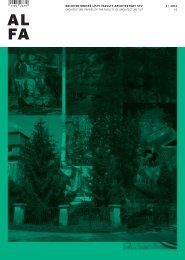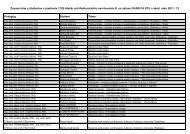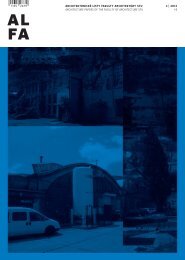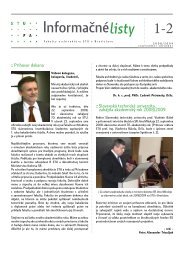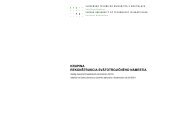ALFA 3-4/2005 - Fakulta architektúry STU
ALFA 3-4/2005 - Fakulta architektúry STU
ALFA 3-4/2005 - Fakulta architektúry STU
You also want an ePaper? Increase the reach of your titles
YUMPU automatically turns print PDFs into web optimized ePapers that Google loves.
Ročník 9<br />
3-4 / <strong>2005</strong> ARCHITEKTONICKÉ LISTY FA <strong>STU</strong><br />
Introduction<br />
Architect Eugene Rosenberg (1907-1990) was born in<br />
Topolcany, Slovakia (than Czechoslovakia). He studied<br />
architecture in famous Gocars’ class at Academy of Fine Arts in<br />
Prague. He travelled a lot during his studies and spent couple of<br />
months working for Le Corbusier in Paris. He also worked for<br />
Honzik and Havlicek in Prague. He established his first own<br />
practice in 1934. He only worked 4 years in Prague and than<br />
immigrated to England. He left Czechoslovakia shortly before<br />
the Nazi invasion in 1938. After difficult war years, he established<br />
partnership with architects Yorke and Mardall. Partners worked<br />
separately on their projects at the beginning, but they soon<br />
changed the policy and acted more under the YRM sign.<br />
Rosenberg worked until 1975. He mostly led the projects of<br />
hospital and industrial buildings. Yorke Rosenberg Mardall, later<br />
called YRM, went through couple changes and exists up to this day.<br />
The following text results the current research of architects’<br />
lifelong work. It is mainly based on the search in Czech, Slovak,<br />
French archives and published works that mention Rosenberg<br />
within YRM or Czechoslovakian interwar architecture.<br />
1. Journeys and practice, schools: Practice at Le Corbusier.<br />
Corbusier's influence on Rosenberg's further work.<br />
Rosenberg's aesthetic functionalism. Rosenberg at Academy<br />
of Fine Arts, School of Architecture. Practice<br />
at Havlicek and Honzik.<br />
1920s and 1930s were typical for their internationalism. Travelling<br />
and connecting with foreign architects became an obvious part of<br />
the profession. In late 1920s, Rosenberg studied at the Technical<br />
University in Prague. As a student he travelled to France, Italy,<br />
Austria, Hungary, Switzerland and Belgium 1. He also had an<br />
opportunity to meet reputable architects from other countries in<br />
Prague, which was a very attractive centre of avant-garde then.<br />
One of the architects, who enjoyed Prague a lot, was<br />
Le Corbusier. When Le Corbusier came to give his second lecture<br />
to Prague in 1928 2, Rosenberg applied for a job in his office.<br />
Three .months later, in January 1929, he got a chance to work for<br />
him. A couple of Czech and Slovak students and young architects<br />
gained similar experience in longer period of time. During<br />
he practice, Rosenberg worked on the designs for Villa Savoy in<br />
Poissy, Draeger factory and Centrosoyuz building in Moscow.<br />
Le Corbusier influenced his further work significantly.<br />
After Rosenberg came back from Paris to Prague he joined<br />
Gocar's class at The Academy of Fine Arts, The School of<br />
Architecture.<br />
Janka KRAMÁRIKOVÁ<br />
ARCHITECT EUGENE ROSENBERG<br />
- 57 -<br />
Before Rosenberg started to work on his own in 1934, he tested<br />
his architecture skills in the office of key figures<br />
of Czechoslovakian avant-garde Honzik and Havlicek.<br />
This time they were designing the Pensions Building in Prague.<br />
He also worked for other successful architects - Jan Gillar and<br />
Josef Štepanek. 3<br />
2. Start: first independent works in Topolcany<br />
His first independent work was created by the time of his stay by<br />
Le Corbusier. It was a dentist’s surgery interior in Topolcany. 4.<br />
After he co-operated with other architects in various architectural<br />
practices all over Prague, he executed another work in his<br />
hometown. He designed Czech Red Cross hospital in 1933. One<br />
year later, he worked on designs of Villa for doctor Mokry - it was<br />
a house and an office for a public provincial physician.<br />
3. Blocks of flats: Apartment houses in Prague<br />
Rosenberg's first executed building in Prague was an apartment<br />
house at Letohradska Street. It was followed by other apartment<br />
houses and low-cost flats in surrounding of Holesovice. They all<br />
have similar features derived from the ideas of aesthetic<br />
functionalism. The facade is composed of a combination of glass<br />
and solid surfaces; it combinates such features as raised middle<br />
part, horizontal windows and loggias on sides. Spaces in flats<br />
seem to be generous, whether we come to small, medium or large<br />
flat. First of all, this is enabled by clever spatial arrangement,<br />
careful choice of materials and use of new technologies.<br />
Rosenberg designed luxorious city apartment houses with new<br />
type of flat, which reminded of one-family house. It became



